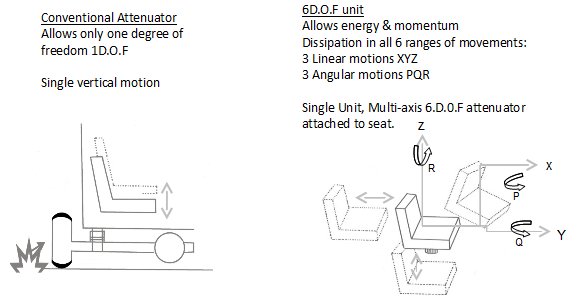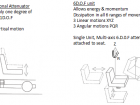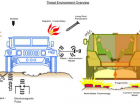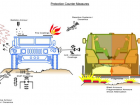News
Next Generation Armour and Blast Protection Systems
Armour development is reflected historically by munitions development. Research in peacetime as well as during war has always seen each era of armour matched by specialised munitions to defeat it. The cycle continues. Perhaps, then, the future development of armour is best described by the expected advances in munitions and how this affects the future of armour?
Armourworks will be developing systems with combined blast wave, fragmentation and ballistic protection in the same panel. This will allow simultaneous mitigation of all three threats with the combination of future single munitions , or permit sequential resistance to each type under coordinated integrated ambush attack designed to degrade conventional lightweight armour. By careful choice of materials, toughening mechanisms, energy management and geometries, ArmourWorks is anticipating and defeating multiple threats.
An important part of protection at ArmourWorks of threat combinations is the suppression of damage to contents and payload, and injury to contained personnel, from large ground blasts created by the more prolific and upscaled IEDs of the future. Improvements to the ArmourWorks product range in blast energy attenuation regarding flooring and wall materials, at present meeting current battlefield requirements, are underway to defeat the blast threats of tomorrow. Advanced development work has begun to build multi-axis blast energy attenuators for blast energy attenuating vehicle seats, along with the research to support it, and will complement present ArmourWorks systems. These advanced attenuators are unique to ArmourWorks, and absorb accelerations not only in the vertical plane, but also operate independently of stroke in any direction, thus suppressing side attacks, roll over and slam-down which limit conventional systems.
With the advent of wide area coverage weapons such as thermobarics, FAX, and the purpose designed anti-vehicle napalm incendiaries of the future, sensible selections of coatings, resins, structural armour materials and their geometries are being developed to mitigate heat transfer and neutralise direct-to-contents attack on vehicle armour. The physical changes produced by materials during attack are well understood and exploited to our advantage.
Increasingly sophisticated radiowave or laser illumination and weapon stabilisation will also appear for more accurate hits and closer shot spacing by smaller, lighter, longer ranged guided missiles and stabilised gun mounts. Such improved target acquisition systems will be countered by managing the vehicles signature.
ArmourWorks methods using non-armour features, such as specialised paints, algorithm generated shapes, materials and active systems to diffuse, absorb, scatter and shift the frequency of such beams and avoid acquisition.
As harder and heavier bullet cores become the norm in AP ammunition, particularly with greater use of larger and larger HMG calibres and autocannon shells, new constructions with new ceramics, metals, engineering polymers and geometries are presently being developed apace. ArmourWorks boasts fast turnaround time for current and future projects, as well as the capability to defeat closely spaced multi-hit hard-core and WC API, SLAP, APDS and APFSDS projectiles. Armourworks is unique in using management of energy and modes of stress to impede the progress of damage through the armour. As demand grows for heavy armour in the future, such as tank armour, careful exploitation of materials, geometries, active and inert systems will be applied by ArmourWorks, all of which are resistant to perforation by long rod penetrators and segmented long rods.
The technologies ArmourWorks employ also simultaneously offer excellent suppression of shaped charges, to cope with the increasing prevalence of infantry unguided RPGs, as well as against advanced guided missiles combining shaped charges, blast and fragmentation units in a single warhead, along with the thermobaric heat soak and incendiary effects of the finely dispersed rocket fuel particles. Future munitions and tactics will favour such integration of both concentrated point impact and wide area coverage attacks, and Armourworks is well advanced in anticipating such threats.
AWI engineers will increasingly interface with vehicle designers to manage new threats being developed by future munitions engineers, such as wide area heat soak, incendiaries, electromagnetic pulse weapons, and the new generation of guided missiles that manoeuvre around the main armour and strike the thinner plates of the rear, topside, underbelly, hatches, and the vehicle gun barrel itself. Armourworks will lead and advise on the wider vehicle systems integration design, to manage and overcome such threats to its mechanical, electrical and passenger survivability.
ArmourWorks Research and Development Group in the UK uses unique encapsulation technology to reinforce armour panels, so there are no natural weak spots such as around edges and corners; as the international standards including STANAG introduce mandatory protocols in the near future to test for such breaches, Armourworks will leave the competition far behind.
In personnel protection, weight versus threat will continue to drive armour development, ArmourWorks are working on increasing armour performance around vital organs while reducing weight around non vital organs, giving the balance of low weight solutions against high threat levels. New materials, geometries, unique energy management and stress dissipation techniques are also used by ArmourWorks to meet the stricter standards of the future. Our plates and vests will satisfy more severe requirements governing velocity, the number and spacing of shots, aggressive oblique strike angles, This is particularly necessary to defeat the high velocity large calibre SLAP and high explosive anti-materiel rounds that have already been used against infantry in recent times, while simultaneously mitigating mechanical blast wave and fragment threats from the latest generation of IEDs. Fundamental work to quantify, codify and suppress blunt trauma mechanisms for different threat levels, using a specially developed modular pack approach, is in progress to meet stricter BFD requirements. For law enforcement armour and shields, these demands plus increased energies and frequencies of threats from knives, spikes and incendiaries are dealt with by an imminent Armourworks programme exploiting smart energy dissipation and containment mechanisms. Applicable to low velocity soft armour systems, these methods use unique coating, weaving and geometric techniques.
ArmourWorks will continue to lead in Survivability solutions.
Written by Dr Lee, Research Scientist at ArmourWorks & Mr Ian Richards, Managing Director.





